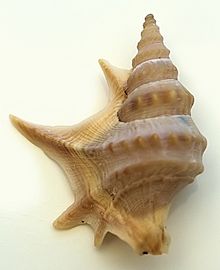Family of gastropods
Aporrhaidae
A shell of Aporrhais pespelecani Catalonia , Spain
Scientific classification
Domain:
Eukaryota
Kingdom:
Animalia
Phylum:
Mollusca
Class:
Gastropoda
Subclass:
Caenogastropoda
Order:
Littorinimorpha
Superfamily:
Stromboidea
Family:
Aporrhaidae Gray , 1850[ 1]
Genera
See text
Synonyms
† Anchurinae Kollmann, 2009 · accepted, alternate representation
Aporrhaididae (misspelling)
Aporrhaiidae (Spelling variation)
Aporrhainae Gray, 1850 · accepted, alternate representation
† Arrhoginae Popenoe, 1983
Chenopidae Deshayes, 1865
† Dicrolomatidae Korotkov, 1992
† Dimorphosominae Kollmann, 2009 · accepted, alternate representation
† Harpagodinae Pchelintsev, 1963 · accepted, alternate representation
† Perissopterinae Korotkov, 1992
† Pterocerellinae Bandel, 2007 · accepted, alternate representation
† Pugnellidae Kiel & Bandel, 1999 [ 2]
† Pugnellinae Kiel & Bandel, 1999 · accepted, alternate representation
Spinilomatinae Gründel, Nützel & Schulbert, 2009 · accepted, alternate representation
† Struthiopterinae Zinsmeister & Griffin, 1995 · accepted, alternate representation
† Tundorinae Bandel, 2007 †
Aporrhaidae is a family of sea snails commonly called the "pelican's foot snails." The taxonomy of the Gastropoda by Bouchet & Rocroi, 2005 [ 3] marine gastropod mollusks in the clade Littorinimorpha .
Aporrhaids are commercially important, especially in traditional fisheries.[ 4]
Description
Aporrhaids have a large lip with finger-like extensions, and a small operculum . They do not have movable eyes. Instead, their eyes are fixed at the base of each tentacle.[ 5]
The mollusk has one narrow foot, which renders its motion interrupted as the foot must raise the shell a tiny bit in each single movement, simultaneously pushing it forward. The motion must be repeated again and again for the mollusk to travel.[ 6]
Habitat
Aporrhaidae live on muddy and sandy bottoms, sometimes in very large populations.
Subfamilies
Subfamilies in the family Aporrhaidae include:
Aporrhainae Gray, 1850 - synonym: Chenopidae Deshayes, 1865
Arrhoginae Popenoe, 1983 - synonyms: Alariidae Koken, 1889 (inv.); Dicrolomatidae Korotkov, 1992
† Harpagonidae Pchelintsev, 1963
† Perissopterinae Korotkov, 1992 - synonym: Struthiopterinae Zinsmeister & Griffin, 1995
† Spinigerinae Korotkov, 1992 (inv.) Aporrhais from the Pliocene of Cyprus.
Genera
There are only two Recent genera:[ 7] [ 8]
Fossil genera within the family Aporrhaidae include:
Alarimella Anchura Antarctohoges Araeodactylus Auriala Austroaporrhais Bicorempterus Ceratosiphon Cultrigera Cuphosolenus Cuphotifer Cyclomolops Diarthema Digitolabrum Dimorphosoma Graciliala Goniocheila Helicaulax Kangilioptera Kaunhowenia Latiala Lispodesthes Maussenetia Mexopus Monocuphus Perissopter Peruchilus Pietteia Platyoptera Pseudanchura Pterocerella Pugioptera Strombopugnellus Struthiochenopus Teneposita Tessarolax Tibiaporrhais Toarctocera [ 9] Rostellaria subpunctata - Toarctocera subpunctata Trilemma Tulochilus Tundora Ueckeritzella Wateletia
References
^ Gray J. E. 1850. Figures of molluscous animals selected from various authors . Etched for the use of students by M. E. Gray. Volume 4. Longman, Brown, Green & Longmans, London. iv+219 pp. Apporhaidae at page 66.^ Kiel S. & Bandel K. (1999). "The Pugnellidae, a new stromboidean family from the Upper Cretaceous". Paläontologische Zeitschrift 73 (1-2): 47-58, 6 Figs., Stuttgart. PDF [permanent dead link ]
^ Bouchet P. & Rocroi J.-P. (Ed.); Frýda J., Hausdorf B., Ponder W., Valdes A. & Warén A. 2005. Classification and nomenclator of gastropod families . Malacologia: International Journal of Malacology, 47(1-2). ConchBooks: Hackenheim, Germany. ISBN 3-925919-72-4 . ISSN 0076-2997. 397 pp. http://www.vliz.be/Vmdcdata/imis2/ref.php?refid=78278
^ "Shells aporrhaidae" . Archived from the original on 2005-03-05. Retrieved 2009-03-07 .^ "Aporrhaidae (Pelicans Foot)" . Archived from the original on 2019-02-22. Retrieved 2009-03-07 .^ "TrekNature | A Pelican's foot for Ahmet Photo" .^ Gofas, S. (2012). Aporrhaidae. Accessed through: World Register of Marine Species at http://www.marinespecies.org/aphia.php?p=taxdetails&id=22988 on 2012-09-27
^ Kronenberg, G.C. 1991: The Recent species of the family Aporrhaidae. Vita marina , 41 (2): 73-84.
^ Gründel, J., Nützel A. & Schulbert C. (24 July) 2009. Toarctocera (Gastropoda, Aporrhaidae): a new genus from the Jurassic (Toarcian/Aalenian) of South Germany and the early evolutionary history of the family Aporrhaidae Paläontologische Zeitschrift (online), PDF
Vaught, K.C. (1989). A classification of the living Mollusca . American Malacologists: Melbourne, FL (USA). ISBN 0-915826-22-4 . XII, 195 pp.
External links

